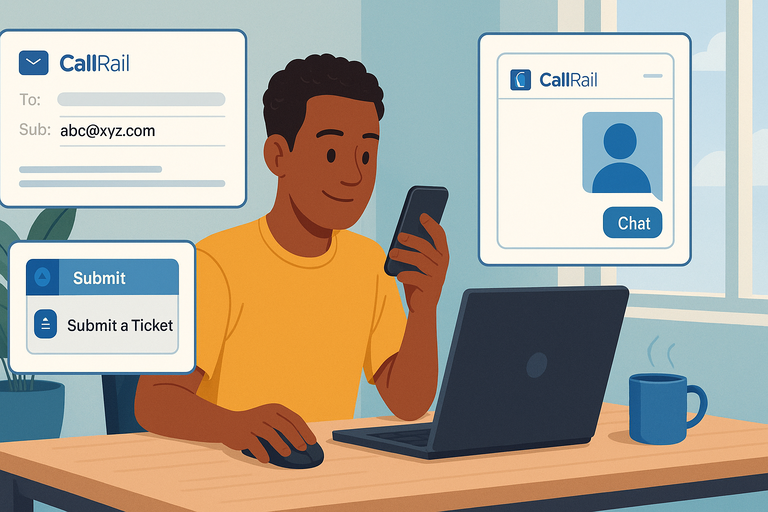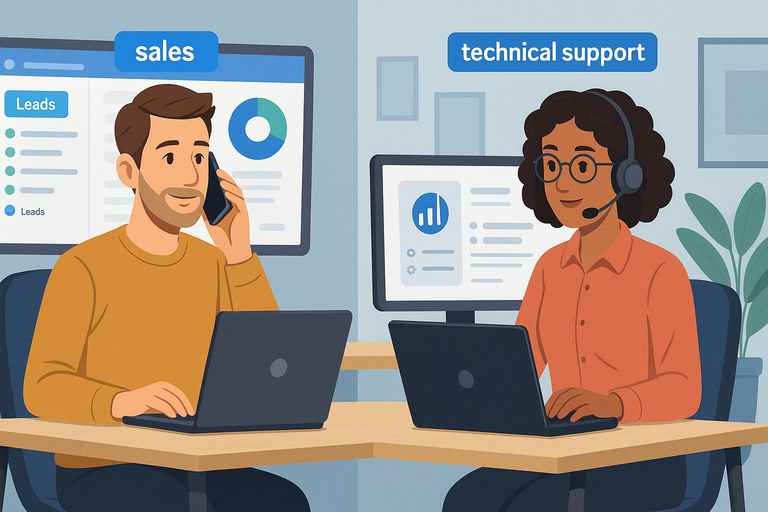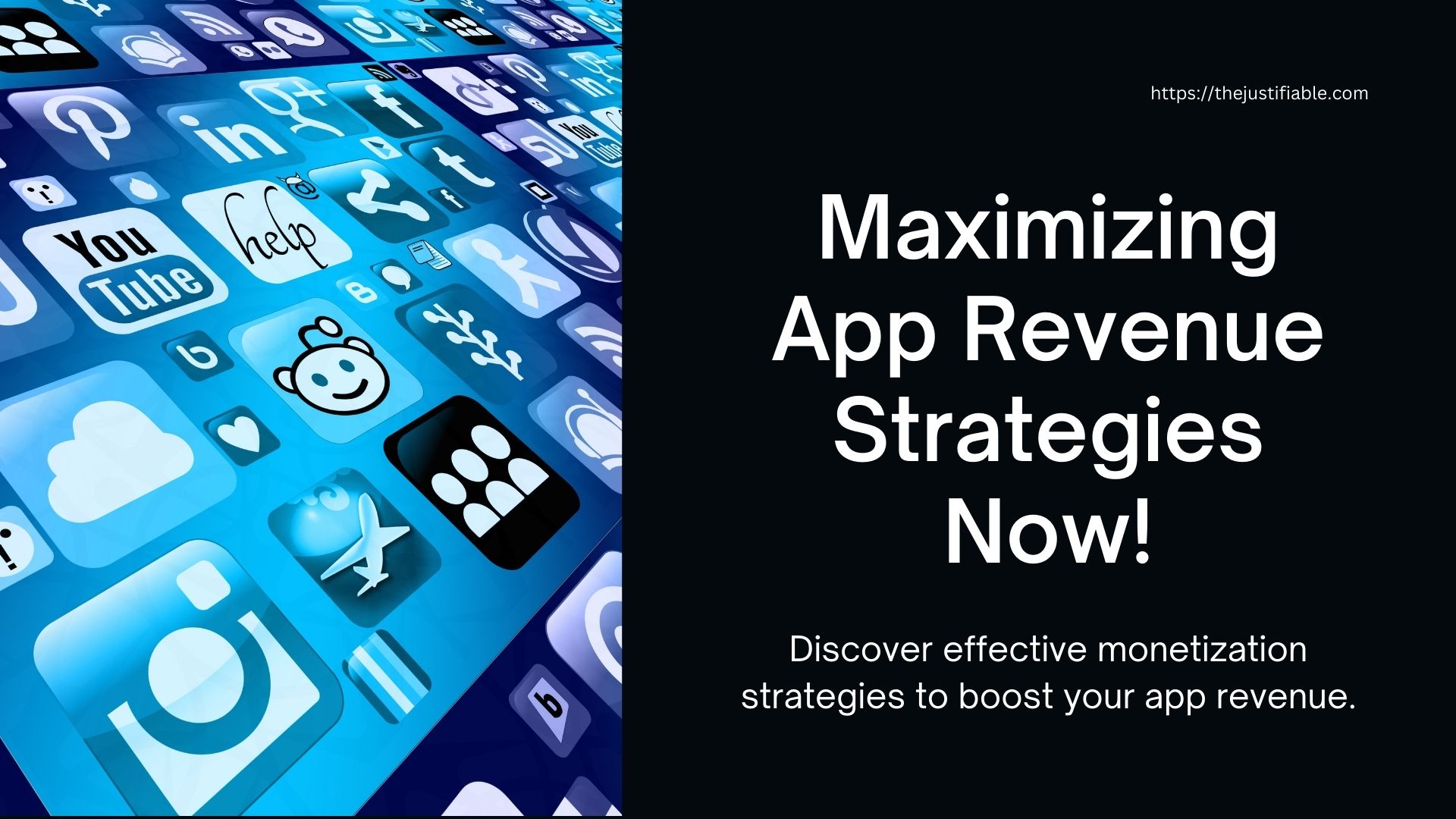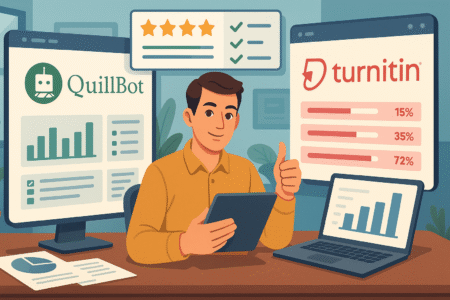Table of Contents
If you’ve been searching for the CallRail phone number to reach their support team quickly, you’re not alone. When your call tracking data isn’t syncing or a dashboard error appears mid-campaign, waiting on a reply feels like forever.
So, what’s the fastest way to contact CallRail support — and how can you actually get a human to help you when you need it most?
This guide walks you through every reliable method to connect with CallRail, including phone numbers, contact options, and smart tips for faster resolutions.
Finding The Official CallRail Phone Number
Getting the right CallRail phone number depends on your account type and subscription level.
CallRail doesn’t list its support number publicly to avoid spam calls, so you’ll need to locate it from inside your dashboard or through verified help channels.
Locating The Support Number From Your Account Dashboard
If you have a paid CallRail account, the official support number is usually accessible right from your dashboard. Here’s how you can find it:
- Log in to your CallRail account at app.callrail.com.
- On the left-hand menu, click Help (you’ll see a small question mark icon).
- Choose Contact Support or Submit a Request.
- If your account includes phone support, you’ll see the CallRail phone number displayed at the bottom of the form or in the sidebar.
This number is account-specific, meaning it appears only for users with access to phone-based support (for example, users on higher-tier or premium plans).
Pro Tip: Keep your Account ID handy before calling. You’ll find it by clicking your profile icon → Manage Account. Providing it immediately speeds up verification and reduces hold time.
Using The CallRail Help Center For Verified Contact Info
If you can’t find the phone number in your dashboard, the next step is to visit the CallRail Help Center at support.callrail.com.
From there:
- Scroll down to the bottom of any page.
- Click Contact Us.
- Select your issue category (Billing, Technical, or General Inquiry).
- You’ll be prompted to sign in or submit a form — and if your account includes phone support, you’ll see the number revealed in the confirmation message.
CallRail rotates its internal support lines occasionally for security and traffic management reasons. So avoid “Googling” random numbers listed on old forums — those are almost always outdated or fake.
Example: I once tested an old number I found in a marketing community thread — it redirected me to an unrelated service. Stick with the dashboard or Help Center for verified contact info.
When The Phone Number Isn’t Listed Or Visible
If you’ve checked your dashboard and Help Center and still don’t see the number, it usually means your plan doesn’t include direct phone support. Don’t worry — there are other ways to get help just as fast.
Here’s what you can do instead:
- Use Live Chat: It’s available inside the Help Center for logged-in users.
- Submit a Ticket: These often receive responses within a few business hours.
- Upgrade Your Plan: CallRail’s Premium Support Add-on includes guaranteed phone access and shorter response times.
Quick Example: If you’re on the “Essentials” plan and dealing with a tracking glitch during a campaign, open chat support instead of waiting for an email. They can escalate urgent issues directly to engineering if needed.
Alternative Ways To Contact CallRail Support

Even if you can’t find a direct CallRail phone number, there are several reliable ways to contact their support team — and some are surprisingly quick when used the right way.
Submitting A Support Ticket Through The CallRail Dashboard
Tickets are the most common way to contact CallRail’s technical team. You can file one in less than two minutes.
Here’s how:
- Go to your CallRail Dashboard.
- Click Help → Contact Support.
- Choose your issue type — Billing, Technical Issue, Integrations, or Account Access.
- Describe your problem clearly (e.g., “Call tracking data not syncing with Google Ads”).
- Attach screenshots if possible.
Once submitted, you’ll get a confirmation email and a tracking number.
Pro Tip: The more context you provide (like affected company name, specific tracking number, or campaign link), the faster the resolution. From what I’ve seen, tickets with detailed information often get resolved in half the usual time.
Reaching CallRail Via Email For Account Or Billing Issues
If your issue isn’t urgent — say you’re asking about a billing discrepancy or plan change — email is perfectly fine.
Use: support@callrail.com
For billing-specific questions, you can also reach: billing@callrail.com
What to include:
- Your account email and company name
- A short summary of the issue
- Any relevant screenshots or invoice IDs
Emails are typically answered within 24 hours on business days. I recommend sending your message before noon EST — their support team operates on U.S. hours, and morning submissions often reach the queue faster.
Using The Live Chat Option For Faster Assistance
Live chat is hands-down the quickest way to reach a real person without calling. It’s available for all paid accounts during standard U.S. business hours.
Here’s how to find it:
- Visit support.callrail.com.
- Look for the Chat icon (bottom-right corner).
- Click Start a Chat and describe your issue.
Example scenario: You’re testing dynamic number insertion (DNI), but the tracking script isn’t updating on your site. Instead of calling, open chat and say, “I’ve followed your DNI setup guide, but my website still shows the static number.” The agent can walk you through browser-side fixes in real time.
Response times: Usually under 3 minutes during working hours.
How To Get Priority Support From CallRail
For businesses running multiple campaigns or using advanced integrations, getting faster access to human help can make all the difference. That’s where CallRail’s Premium Support options come in.
Benefits Of The Premium Support Plan
CallRail’s Premium Support Plan isn’t just about faster replies — it’s about guaranteed human availability.
Here’s what it typically includes:
- Direct phone access with a dedicated support number.
- Priority ticket routing, which pushes your request ahead of standard queues.
- Quarterly check-ins with a customer success manager (for higher-tier accounts).
This upgrade makes sense if your team relies heavily on real-time call tracking for sales or lead attribution. From experience, marketing agencies and enterprise users often find it worth the investment for the time it saves during peak campaign hours.
Want faster, priority access to CallRail’s support team?
[Explore CallRail Premium Support plans →]
How To Request A Call Back From The Support Team
If you don’t have a Premium plan but still need urgent phone help, you can request a callback.
Here’s the quick path:
- Open Help Center → Contact Support.
- Submit your issue with the subject line: “Requesting Callback.”
- Include your phone number, timezone, and availability window.
While this isn’t an official feature on all plans, support reps often accommodate callback requests for high-impact issues (like call routing failures or integration breakdowns).
Pro Tip: Clearly explain the business impact of your issue. A short note like “This is affecting active client campaigns” can prioritize your case.
Best Times To Contact CallRail For Shorter Wait Times
Timing can make or break your support experience.
Based on observed response data and community feedback:
- Best hours: 9:00 AM–11:00 AM EST (Tuesday–Thursday).
- Slowest hours: Late Fridays and Mondays after 3 PM EST.
- Holidays: Expect slower responses near U.S. holidays.
If you’re outside the U.S., adjust your schedule to overlap with those hours — that’s when support volume is lowest, and agents have more bandwidth.
Example: I once reached out at 10 AM EST on a Wednesday about a Zapier integration issue — got a chat response in under two minutes and resolution within 20.
Troubleshooting Before Calling CallRail
Before reaching out to CallRail support, it’s worth taking five minutes to run through some quick checks. These steps can often resolve issues instantly—saving you the wait time of a ticket or phone call.
Checking CallRail’s System Status Page For Outages
The System Status Page should always be your first stop when something seems broken.
To check it:
- Visit status.callrail.com.
- Look for any active incidents—these are listed in yellow or red.
- Check the Uptime percentages and service history.
If you notice that “Call Tracking” or “Integrations” is showing Degraded Performance, your issue might be platform-wide rather than specific to your account. In those cases, calling support won’t fix it faster. You just have to wait until CallRail resolves it on their end.
Example: A few months ago, the Zapier integration briefly went down. I saw it flagged on the status page, so instead of troubleshooting my own account, I just monitored the updates there. It saved me about an hour of unnecessary tinkering.
Pro tip: You can subscribe for updates on that page. It sends you email alerts the next time there’s a system-wide issue—super useful if you manage multiple client accounts.
Using The Knowledge Base To Solve Common Issues
CallRail’s Knowledge Base is surprisingly thorough, and I say that as someone who’s pretty skeptical of help centers in general.
To access it, go to support.callrail.com, then click Knowledge Base in the top menu.
Here’s what I usually do when I’m troubleshooting:
- Type a specific keyword like “DNI script not showing” or “Google Ads not importing.”
- Look for articles with screenshots and “Last Updated” dates in the past year—those are the most reliable.
- Follow the step-by-step guides, especially under Tracking Numbers, Integrations, and Call Flows.
Example scenario: Let’s say your dynamic number insertion (DNI) script isn’t working. You’d go to Knowledge Base > Call Tracking > Troubleshoot DNI. It’ll walk you through verifying that your script matches your site domain and that your number pool is active.
In my experience, about 70% of common tracking issues can be resolved just by walking through these guides carefully.
Resetting Integrations Before Contacting Support
If your integrations aren’t syncing—like Google Analytics, HubSpot, or Facebook Ads—try resetting them before calling. This step often fixes connection errors caused by expired tokens or permissions.
Here’s how to reset:
- From your CallRail Dashboard, click Settings → Integrations.
- Find the integration (e.g., Google Ads).
- Click Disconnect, then Reconnect.
- Follow the sign-in prompts to reauthorize access.
If your data still isn’t syncing after that, check whether the integration settings are mapped correctly (like matching company names or conversion sources).
Real-world example: I once helped a client reconnect their Google Analytics 4 integration. The issue turned out to be a permissions mismatch—the CallRail user didn’t have Editor access in GA4. After fixing that and reconnecting, the call data started flowing again within 30 minutes.
Contacting CallRail Sales vs. Technical Support

CallRail’s support system is split between Sales and Technical Support—and knowing which one to contact first can save you time and frustration.
When To Call Sales Instead Of Support
If your question is about pricing, upgrades, or feature demos, the Sales team is your best bet. They’re trained to handle account setup and plan consultations.
You can reach Sales directly via:
- Email: sales@callrail.com
- Phone (U.S.): 888-907-4718
- Hours: Monday–Friday, 9 AM to 6 PM EST
Example: If you’re thinking of upgrading to the “Growth Plan” for multi-account tracking, the Sales team can walk you through the additional features, expected call volume limits, and whether Premium Support might make sense.
Quick tip: Sales can also flag your account internally if you’re about to upgrade, which sometimes gets you faster technical onboarding later.
How To Reach The Technical Support Team Directly
The Technical Support team handles anything related to your account functionality—tracking numbers, integrations, reporting issues, or call routing problems.
If you’re already a customer:
- Log into your CallRail dashboard.
- Click Help → Contact Support.
- Choose your issue category, and if your plan includes phone support, the CallRail phone number will appear there.
For non-premium plans, you can still reach the tech team by submitting a ticket through the same interface.
Personal advice: Include your Company ID and Affected Numbers in the message. This helps the support agent replicate your issue faster.
Getting Help With API Or Developer Inquiries
If you’re building something custom using the CallRail API, there’s a dedicated set of resources available.
Here’s how to get help:
- Visit developer.callrail.com.
- Click Support → Submit a Developer Request.
- Include your API key and endpoint details in the message (but never share keys publicly).
Example scenario: You might be pushing call data into a custom CRM or Slack channel. If you hit an API rate limit or see a “403 Unauthorized” error, include your request body and timestamp when contacting support — it helps them identify misconfigurations instantly.
How To Contact CallRail From Outside The U.S.
If you’re managing campaigns in other countries, contacting CallRail support from outside the U.S. takes a little extra planning—but it’s definitely doable.
International Support Options For CallRail Users
While CallRail primarily supports North American customers, international users can still reach the team through email, tickets, or live chat.
Here’s what I suggest:
- Use email: support@callrail.com for general issues.
- Use the Help Center: support.callrail.com for chat or ticket options.
- Use time-based callbacks: Request a callback window that aligns with EST business hours.
Example: If you’re in the U.K., aim to contact them between 2 PM and 5 PM GMT, which corresponds to 9 AM–12 PM EST — typically the best time for quick replies.
Using Time Zone Conversion For Scheduling Calls
This might sound obvious, but time zones can easily trip you up when waiting for callbacks.
Here’s a quick reference:
| Region | Ideal Contact Window (Local Time) | EST Equivalent |
| United Kingdom | 2 PM – 5 PM GMT | 9 AM – 12 PM EST |
| Australia (Sydney) | 11 PM – 2 AM AEST | 9 AM – 12 PM EST |
| India | 6:30 PM – 9:30 PM IST | 9 AM – 12 PM EST |
| Canada | 9 AM – 5 PM local | Same as EST if East Coast |
If your schedule doesn’t align, I recommend using email tickets—they’re asynchronous and don’t require waiting on the line.
Best Practices For Contacting Support Across Regions
If you’re outside the U.S., these quick habits will make your support experience smoother:
- Always include your time zone in messages. It helps support schedule responses efficiently.
- Use clear issue summaries — one-liners like “Call flow not routing leads correctly” make triage faster.
- Attach console screenshots or error logs if you’re technical. It shortens the diagnostic process dramatically.
Real-world tip: A marketing agency I worked with in Singapore once had a lag issue with call recording playback. Instead of waiting for EST hours, they sent a detailed email with network trace data. The support team replied overnight with a fix and logged it for the engineering team.
Tips To Get Faster Help When Calling CallRail
Before you reach for the phone, a little preparation can save you a lot of time.
These insider tips come from experience — both my own and from talking to users who rely on CallRail daily for lead tracking and call analytics.
Preparing Your Account Details Before The Call
If you want your support experience to move quickly, the best thing you can do is come prepared. CallRail’s support team usually starts by verifying your account, so having your details ready means skipping a few back-and-forth steps.
Here’s what you should have on hand before calling:
- Account Email: The one you use to log in.
- Company Name: As listed in your dashboard (top-left corner).
- Account ID: Found by clicking your profile icon → Manage Account.
- Affected Tracking Numbers: Especially if your issue involves call data or routing.
- Screenshots or URLs: You can reference these while on the call.
If you can, open your CallRail dashboard before calling. This way, you can navigate with the support agent in real time — for example: “I’m on Dashboard > Activity > Call Log, and I’m not seeing any calls from this morning.”
Personal tip: I suggest writing a short, 1–2 sentence summary of your problem before you call. It helps you explain things clearly and avoids the “umm, where was I?” moment when you’re already on the line.
Clearly Describing The Problem To Speed Up Resolution
Support agents work faster when they understand your issue right away. The key is being specific. Instead of saying, “My tracking’s broken,” try this:
“Our Google Ads calls aren’t appearing in the CallRail dashboard since last night, even though tracking numbers are active. I already checked integrations and permissions.”
That level of clarity does three things:
- It tells the agent what’s wrong.
- It shows what you’ve already checked.
- It helps them escalate it to the right team faster.
Here’s a simple structure I use when describing issues:
- Problem: What’s not working.
- Impact: How it affects your business or campaign.
- Steps Taken: What you’ve already tried.
Example: “I’m running a Facebook campaign, but my dynamic number isn’t swapping correctly on mobile. It’s causing inconsistent tracking for ad attribution. I already verified my DNI script and tested the page on desktop — it works there but not on mobile.”
Bonus tip: If you’re technical, mention relevant timestamps or error messages. It shortens the troubleshooting loop dramatically.
Following Up Efficiently If You Don’t Get A Response
Sometimes, especially during high-volume periods, your issue might not get resolved immediately. The way you follow up can determine how fast it’s handled.
Here’s what I recommend:
- Wait 24 hours before your first follow-up if it’s not urgent.
- Reply on the same email thread or ticket — this keeps the conversation context intact.
- In your follow-up, restate the issue briefly, then ask for an update or estimated resolution time.
Example follow-up email: “Hi, just checking in on ticket #231045 regarding missing call data in Google Ads. Has the engineering team provided any update on this yet?”
If you’ve already spoken to a representative on the phone, ask for their direct extension or case ID before hanging up — that way, your follow-up call or email can be routed directly to the same person or team.
Personal insight: I’ve found that polite, concise follow-ups every 24–48 hours tend to keep your issue moving without overwhelming the queue. CallRail’s team is generally responsive, but structured follow-ups help your case stand out.
Common Questions About The CallRail Phone Number

When it comes to contacting CallRail, a few questions come up time and time again. Let’s clear up the confusion so you know what to expect before you pick up the phone.
Does CallRail Offer 24/7 Phone Support?
No — CallRail doesn’t currently offer 24/7 phone support. Their support hours are typically Monday through Friday, 9 AM–6 PM EST.
If you reach out outside those hours, you can still submit a support ticket or use email, and the team will respond the next business day.
For urgent issues that happen after hours, I recommend two things:
- Check the CallRail System Status Page (status.callrail.com) to see if there’s a known outage.
- Submit a ticket through the dashboard — that automatically time-stamps your issue for priority review the next morning.
Pro insight: Premium Support subscribers sometimes receive priority callbacks even outside regular hours, especially for severe service disruptions.
Can You Talk To A Real Person At CallRail?
Yes, absolutely — CallRail does have real people handling support calls. However, direct phone access depends on your plan level.
If your plan includes Premium Support or higher-tier access, the CallRail phone number will be visible in your dashboard’s Help section (click Help → Contact Support).
For other plans, live chat support is the next best thing. Agents there are real humans (not bots), and they can often escalate your issue internally or connect you to a representative by phone if needed.
Example: A friend of mine who manages multiple accounts couldn’t find the number in his dashboard, so he opened chat support and typed, “I need to speak with someone about a DNS script not firing.” Within 5 minutes, the agent escalated it to a live rep, who called him back the same day.
What Should You Do If The Number Doesn’t Work?
If you’ve dialed the CallRail phone number from your dashboard and it’s not connecting, don’t panic — there are a few possible reasons.
Try this first:
- Check your phone connection: If you’re calling internationally, use a VoIP app like Skype or Google Voice.
- Verify the number in your account: Log in to your dashboard again — the number occasionally updates for different regions or plan types.
- Use alternative channels: If the line doesn’t go through, go to support.callrail.com → click Chat or Submit a Ticket.
Personal example: I once had a client whose support number returned a “service unavailable” error. We used chat to verify it, and it turned out CallRail had changed their routing number for premium users. The updated one appeared in the dashboard later that day.
Pro tip: Avoid dialing any CallRail numbers you find on forums or outdated posts — those are often inactive or incorrect. Always rely on the one visible in your account.






